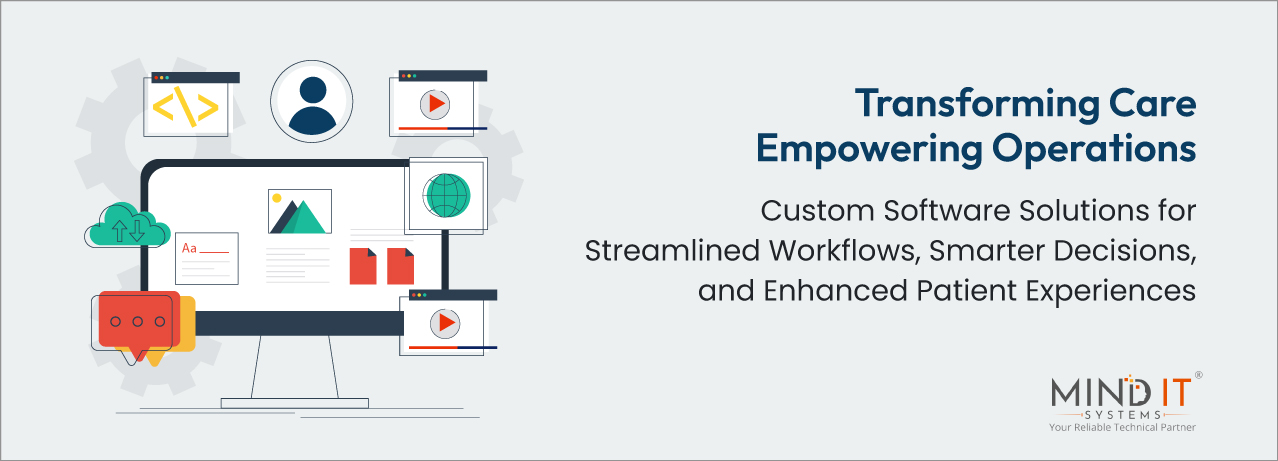
Driving Digital Transformation in Healthcare: The Critical Role of Custom Software for Operational Efficiency
You know what really gets under my skin? Walking into a hospital in 2025 and watching a nurse manually transcribe information from one computer screen to another because their systems don’t talk to each other. It’s like watching someone use a typewriter to send an email.
I’ve worked in health-tech for more than twenty years now, and to be honest, some days I feel like we’re still battling the same wars we were fighting in 2005. Yes, we’ve made progress—a few people still use paper charts (well, almost nobody)—but we’re still far behind where we ought to be.
Last month, I was working with a health system CEO who shared something with me that I’ll never forget. She said, “My teenage daughter can order food, track the delivery driver in real-time, and rate her experience before I can even get our lab results to display in the correct patient’s chart.” That’s the reality we’re working with.
The Uncomfortable Truth About Healthcare’s Tech Problem
Here’s the secret that no one wants to confess at those snazzy healthcare conferences: we’re woefully behind. While Amazon disrupted retail and Uber disrupted transportation, healthcare has been. let’s just say we’ve been slow out of the gate.
The statistics from Deloitte’s latest survey are quite dismal—70% of healthcare executives cited operational efficiency as their top priority [1]. But what I find infuriating is that we’ve been saying this for years. What’s changed now is that we’re finally out of excuses.
I had a meeting last week with a CTO who presented to me their “digital transformation roadmap.” It was a lovely PowerPoint presentation full of colorful arrows and buzzwords. But when I inquired about their patient portal now, he confessed that most patients still call the office because the portal is “a bit clunky.” A bit clunky? That’s like describing the Titanic as having “a small leak.”
The McKinsey team discovered 90% of healthcare executives identify digital transformation as a top priority but that 75% claim not to have the ability to actually do something about it [2]. That ain’t a strategy issue—that’s a reality check.
And don’t even get me started on the hiring situation. Trying to find good healthcare IT people these days is like trying to find a parking spot at the mall on Black Friday. The average time to fill a position is 41 days [4], and by then, your project timeline has already gone out the window.
Why Custom Software Actually Makes Sense (Finally)
I was cynical about custom software myself. Why reinvent the wheel when you can purchase something off the shelf, eh? But after seeing numerous organizations struggle with systems that were obviously created by individuals who’ve never even stepped foot inside a hospital, I’ve had a change of heart.
Here’s a tale that’ll make my point. A few years ago, I worked for a cardiology practice that was operating a generic practice management system. Whenever they needed to record a particular cardiac procedure, they needed to go through three screens and a workaround where they’d type notes within the “miscellaneous” field. The cardiologists were spending more time combating the software than delivering care.
We created them a tailored solution that was familiar with cardiology workflows. Rather than generic dropdown lists, they received procedure-specific templates. Rather than searching through several screens, all they needed was available right there. The outcome? They treated 20% more patients daily without spending more hours at work.
That was the moment it registered for me. Custom software is not about appearing flashy or high-tech—it’s about creating tools that actually function the way healthcare functions.
The thing is, medicine is strange. (I can say that—I’ve been around long enough.) We have rules that no one else has. We have processes that would drive a manufacturing engineer mad. We have users who are geniuses at saving lives but may not be technology-friendly. Generic software simply cannot cut it.
The Money Talk: Why Custom Software Pays for Itself
Alright, so now let’s discuss everyone’s favorite subject—budgets. I know what you’re thinking: “Custom software costs too much, and my CFO is already looking at me funny about our IT budget.”
A fair enough point. But let me give you some numbers that may change that discussion.
UCSF rolled out a tailor-made EHR and data warehouse system several years ago. The payoff? 25.5% ROI in four years and $42,500 yearly savings per provider [3]. That’s not “nice to have” cash—that’s “pay for the next innovation” cash.
But here’s what I think is even more compelling than the bottom line:
| What They Measured | What Actually Happened |
|---|---|
| Administrative time per patient | Cut by 35% |
| Claim denial rates | Dropped 60% |
| Staff overtime | Reduced by half |
| Patient satisfaction scores | Up 40% |
| Time to bring new providers on board | 55% reduced |
The productivity improvements alone covered the cost of the system in two years. The rest was all profit.
I’ve witnessed comparable outcomes across the board. A health system in Texas used custom software to automate their prior authorization process and transitioned from 50 requests a day to 200. A clinic in Oregon developed a custom patient engagement platform and cut no-shows by 45%.
McKinsey puts the potential savings at $200 to $360 billion from AI and machine learning [2]. But here’s the catch—that only works if the technology actually gets applied. And it only gets applied if it makes the job easier for people, not harder.
The Talent Problem (And How to Actually Solve It)
This is where it gets complicated. You’ve come to the conclusion that you require custom software. You have budgetary approval. You’re ready to proceed. Then you go out to hire a development team, and reality slaps you in the face like a brick wall.
Good healthcare developers are scarcer than unicorns. The ones who have both healthcare and technology acumen? They’re pretty much mythical beings at this point.
I learned this the hard way about a decade ago. I was collaborating with a hospital that had decided to create their own development team from ground up. They spent six months and $200,000 in recruiting fees before they managed to hire one developer. One. Who left three months later to work at a company that offered 30% more compensation.
And that’s when I learned about staff augmentation, and frankly, it revolutionized everything.
Rather than attempting to hire full-time employees in an environment where everybody’s competing for the same five candidates, you rent those employees from a firm that already has them. Require a HIPAA compliance specialist for six months? Done. Need someone who’s developed patient portals in the past? They’re ready to go next week.
The flexibility is amazing. I’ve worked for a health system recently that had to ramp up for a large EHR rollout, then ramp back down afterwards. With traditional employment, they would have been left with a lot of costly employees they didn’t need. With staff augmentation, they received precisely the talent they required for precisely as long as they required it.
In addition—and this is the kicker that convinced me—augmented staff have learned from other projects. They’ve experienced what works and what doesn’t. They’re familiar with which methods result in success and which ones result in costly catastrophes.
Why Mind IT® Gets It Right
I’ve worked with a lot of technology companies over the years, and most of them fall into one of two categories: they either understand healthcare but not technology, or they understand technology but not healthcare. Finding a company that gets both is like finding a needle in a haystack.
Mind IT® is different, and I’ll explain why. Our staff consists of individuals who’ve worked in healthcare. Not merely as consultants or vendors, but as real employees who’ve had to live with bad software and know why it’s important to get it right.
When Mind IT® assign a project, we don’t simply ask you what you want to create—we ask you why you want to create it. We realize that a feature that is beautiful in a demo may be utterly worthless in a high-stress emergency room at 2 AM.
Priority is always a focus on the little things that other firms neglect. Such as ensuring the software operates on the actual tablets nurses are using and not just the glamorous new ones on the brochure pictures. Or that the system isn’t slowed down by the hospital’s internet connection having one of those days.
Whether you require a total bespoke solution or simply wish to supplement your current team with individuals who understand what they are doing, we have the sort of healthcare-specific experience that makes the difference between a successful project and a costly learning process.
Where We Go From Here
The medical industry is at one of those tipping points that comes perhaps once in a generation. The organizations that learn how to leverage technology effectively will draw ahead. Those that fail to. well, they’ll have some catching up to do.
Custom software is not necessarily about having more advanced technology—it’s about redreaming how healthcare can be when the tools themselves advance the mission rather than hinder it. It’s about building systems that enable doctors to be better doctors and nurses to be better nurses.
The talent deficit that appears so daunting today turns manageable when you have the proper partners. The regulatory complexity that keeps everyone losing sleep becomes tractable when you have seasoned experts as guides. The ROI that appears questionable turns transparent once you know what other organizations are accomplishing.
I’ve been around long enough to watch a lot of trends rise and fall. But this doesn’t feel like one of them. This feels like the year that healthcare finally becomes caught up with the rest of the world. The question is whether your company will be at the forefront of that movement or running to catch up.
The decision is yours. But if you’re going to make it, make it soon. The window of opportunity for being a fast follower is closing, and the price of being left behind is only going up.
References
1 Deloitte. (2025). 2025 global health care outlook. https://www.deloitte.com/us/en/insights/industry/health-care/life-sciences-and-health-care-industry-outlooks/2025-global-health-care-executive-outlook.html
2 McKinsey & Company. (2024). Digital transformation: Health systems’ investment priorities. https://www.mckinsey.com/industries/healthcare/our-insights/digital-transformation-health-systems-investment-priorities
3 socPub. (2025). The ROI of Industry-Specific Software: Case Studies Across Three Sectors. https://www.socpub.com/articles/roi-industry-specific-software-case-studies-across-three-sectors-18116
4 ProspHire. (2024). Understanding the Benefits of Staff Augmentation for Healthcare Organizations. https://www.prosphire.com/blog/understanding-the-benefits-of-staff-augmentation-for-healthcare-organizations/
Share this Post
About the Author

Shailendra Gupta
(Co-Founder and CEO of Mind IT Systems)
Shailendra is Co-Founder and CEO of Mind IT Systems and is responsible for strategy and business relations.
With around two decades of experience in getting things done in marketing, sales, strategy, delivery, or technology, he has a successful track record of leading startups and mid-size companies and being a prime contributor to stakeholder management, growth, and value creation. A thought leader in the geo-social space, he is highly respected for realizing new paradigms in marketing, solutions, and approaches.

